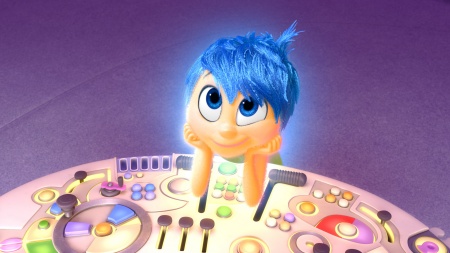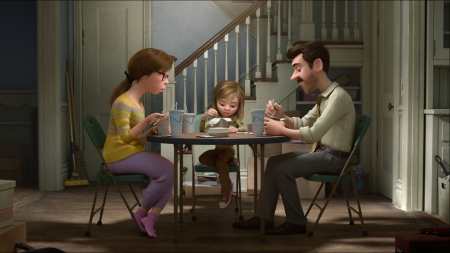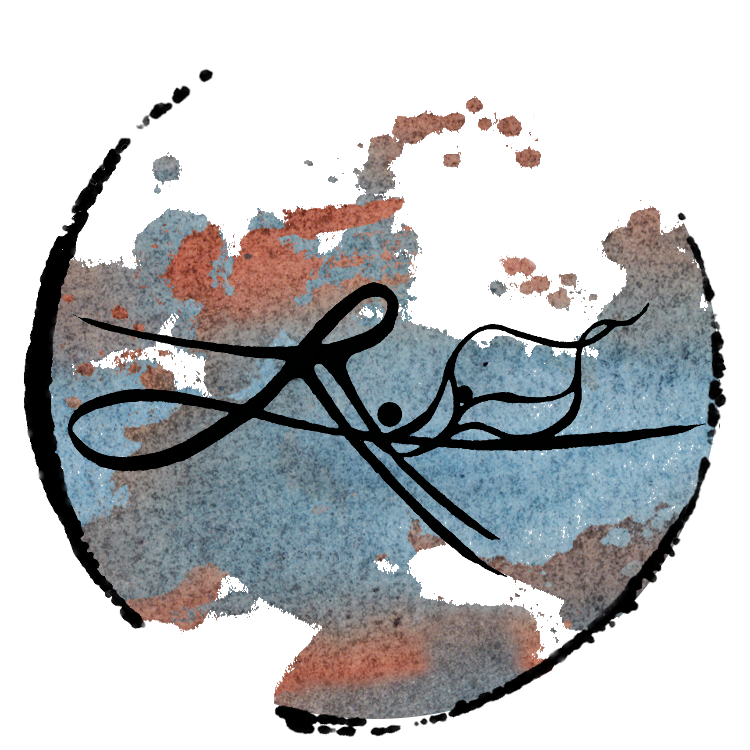Back, back, back in the back of your mind
Are you learning an angry language?
Tell me boy, boy, boy, are you tending to your joy?– Ani DiFranco, “Back, Back, Back”

Last week, I took my stepkids to see the new Pixar movie, Inside Out, a story about the personified emotions that live inside the mind of an 11-year-old girl named Riley. Spoiler alert: not only was it fun for the whole family — with lots of laughs (pretty much every time Lewis Black had a line) and tears (damn you, Pixar, and your ruthless tugging of my heartstrings) — but it was also a fascinating exploration of what a Pagan might call the “inner landscape,” the wilderness of the soul. From the fey bizarreness of Imagination Land and Dream Production to the perilous realm of Abstract Thinking, the shadowy caverns of the Subconscious, and the vast labyrinthine halls of Long Term Memory (maybe they even lead into the Akashic records?)…
It was particularly interesting to see how each of my stepkids responded to the movie. The youngest (who is ten years old) demanded to know why love wasn’t included as one of the emotions. “Is love just an emotion,” I asked her, “or is it an action, something we choose to do?” After a somewhat skeptical pause, she replied, “No, it’s an emotion!”
Kids. They say the darnedest things. You never know what they’re picking up by osmosis from the rest of society, even without you realizing it.
When I asked them what they thought the movie was trying to say, the littlest piped up again, “That you can’t really appreciate good things like joy, without the bad things, like sadness. You have to have bad things so that the good things stand out more.”
“Really? Where did you learn that?” I asked her. I like to torture my kids with the Socratic method, which has led to some awesome conversations but can also sometimes backfire. This time, I was just too surprised to sound dispassionately curious. The kids could tell that I Had Opinions, and it put them on the defensive.
“I didn’t learn it anywhere, nobody told it to me. It’s just true!” the youngest objected.
There are lots of adults who believe this, too. In fact, there are a lot of Pagans who will use exactly this explanation for why we embrace both darkness and light, both life and death, as essential and sacred aspects of the spiraling cycle of existence. And that’s a fine explanation, as far as it goes…

The trouble is, it doesn’t actually get us very far. This kind of dualism doesn’t even get us to the heart of what Inside Out is challenging us to question: whether our classifications of the world — as well as our own inner landscape and its denizens — as good or bad, positive or negative, useful or useless, is maybe missing the point.
We are used to thinking of certain emotions like anger, fear and sadness, as “negative”… and yet, in the wilds of the inner world, each serves a purpose. Inside Out introduces us to Fear as a desire for safety and stability that allows us to assess risks and plan for the future. The emotion of Anger, the movie suggests, is rooted in our desire for fairness and equality, our need to see that the world is both just and beautiful (and doesn’t contain an abomination like broccoli pizza). Even Disgust (who also has something to say about broccoli pizza) has a role to play: helping us to establish and maintain healthy boundaries, to keep out the literal and metaphorical poisons that might harm us.
And what about Sadness? Does it have a purpose? Is it just a “negative” emotion that we should only acknowledge when we need it to help Joy shine more brightly? That’s the question that Inside Out challenges us to ask ourselves, and it’s what the story of 11-year-old Riley and her emotional upheaval attempts to explore. The belief that “we need negative things so that we can appreciate positive things” is where the story begins, but it’s definitely not where we end up by the closing credits.
My oldest stepdaughter, by now a well-trained diplomat and peacemaker in family arguments conversations, asked me what I thought the movie was trying to say. “I think the movie is saying that Sadness helps us to connect with others, and it invites others to connect with us.” I told her. “Sadness allowed Riley to be vulnerable and open, and she was also able to be gentle and compassionate with others, to offer them a safe space when they were feeling vulnerable. Joy is fun and uplifting, but she can be kind of relentless, even selfish, when she’s not tempered by this awareness of how fragile we all can be sometimes…”

Inside Out is not only about discovering the meaningfulness of Sadness, but coming to appreciate the limitations of Joy — why a life (and a society) built around the pursuit of happiness can sometimes lead us astray. Throughout the movie, Joy struggles to lug around an armful of glowing, bowling-ball-sized memories of happy childhood moments, to hold onto them no matter what and protect them from any touch of Sadness (who can’t seem to help wanting to reach out and touch everything). When we become hoarders of happiness — whether these are experiences of earthly joys, or moments of spiritual ecstasy and divine blessing — those experiences can become a burden that keeps us from living a full and adventurous life. Without such experiences, it’s true that we can begin to shut down. But when we obsess over our own happiness as if it were an emotional commodity, something we can acquire, possess or consume, we risk losing our way and cutting ourselves off from the fullness of life in complex relationship with the world around us.
Meaningful, complex relationships require us to nurture complex inner lives, in which a diversity of desires and values can thrive. Another thing I’ve heard a lot of adults (who really should know better) claim is that “you can’t control your emotions.” This is one of those half-truths that can easily become an excuse to get a little lazy in our journey towards self-knowledge. And it’s one that Inside Out grapples with in a surprisingly nuanced way, considering it’s a kids movie featuring a talking pink elephant-cat-hybrid.
Can you control your emotions? Should you? I winced when, at the beginning of the movie, Riley’s mom asks her to keep smiling because her joyful presence is such a big help as their family struggles with their move to a new city. Warning bells were going off in the parenting part of my brain: You don’t ask a child to be happy for your sake! Riley’s Joy, who acts a lot like a loving inner-parent at times, also tries to circumscribe the role of Sadness in Riley’s inner life. Like many of us, Riley has both internal and external forces at work, and her own emotions play a role in keeping each other in check. Later, after Joy and Sadness get sucked away and lost in the wilds of Riley’s inner landscape — leaving only Anger, Fear and Disgust to man the control board at Headquarters — these three remaining emotions frantically try to keep things running until Joy gets back. They try to “do what Joy would do”… and of course, this only leads to one mess after another.

Is this simply Riley trying to “control her emotions” and failing? Is the problem that she isn’t letting her emotions direct her actions, or do they have too much control? What’s really going on here?
Pagans might call this problem “soul fragmentation.” There are numerous practices and traditions that center on the process of retrieving those bits and pieces of ourselves that have gotten lost or forgotten as the result of trauma in our lives. Inside Out is a modern-day story of the shamanic journey into the Otherworld, a journey of both self-recovery and self-discovery.
In this Other-/inner world, we encounter guides and companions that help us along the way and provide us with magical gifts, as well as monsters lurking in the dark… and even mischievous sprites who delight in niggling us with annoying TV ad jingles. A product of our modern mostly-materialist society, Inside Out portrays this world as entirely within a person’s individual mind, but many cultures from around the world have understood that there are no hard-and-fast boundaries between what is “inside” and what is “out.” The inner world and the Otherworld mix and mingle, with only a thin, ever-shifting veil between them. Either way, the journey into the wilds of this inside-out realm serves the same purpose: it is a time when we are tried and tested, when we discover wildly diverse aspects of ourselves and learn what their strengths and limitations really are.
Inside Out even offers us a peek of what might happen if we fail in this endeavor. If you’re one of those folks who likes to sit through a movie’s end credits, you’ll be treated to glimpses “inside” a number of other characters — including the pizzeria hipster chick, the “cool girl” at school, and the angry bus driver. These glimpses are not only funny but shockingly poignant, as they show individuals whose emotions have been reduced to poor copies of each other. The hipster chick’s emotions all roll their eyes along with her Disgust; the bus driver has five versions of Anger at the wheel, all fuming over the traffic. When Joy and Sadness are lost, we see Riley begin to slip down this path as well — her other emotions try to imitate Joy, to make up for that absence. When we lose touch with a part of ourselves, other aspects of the self may step in to try to “play the part.” Perhaps there was a time when that angry bus driver lost touch with his sense of fairness and justice, and so eventually his own joy, disgust and fear were enlisted to compensate. How many of us have done the same, mistaking our self-righteousness or rage for a sense of joy?

Ultimately, the shamanic journey of soul retrieval is about restoring our integrity, the wholeness of the self. Through this journey into the Otherworld, we find that dynamic balance in which our own complexity and inner diversity can shine. When we lose our sense of joy — or our ability to grieve, or our desire for justice, or our strength to maintain healthy boundaries — then we need to “practice happiness,” as the singer Ani DiFranco puts it, tending to our joy, or our sorrow, or our anger. This isn’t merely trying to exert control over our emotions. It’s about cultivating inner flexibility and creativity. The result of such a journey is a wild and complex inner landscape, in which the many aspects of ourselves continually challenge and temper one another, engaged in an on-going sacred conversation of discovery. May we find ourselves centered and grounded in the harmonies of those many voices.
Photo Credits:
All pictures are screenshots from Inside Out, ©2015 Disney•Pixar. All Rights Reserved.
While You’re Wondering:
Are Pixar movies secretly animist? Check out this fascinating article on the personhood of non-humans in Pixar films.

One of the most delightful things about the movie is the way in which it portrays Riley’s psyche, not as a one-person-in-charge despotism or a profit-or-goal-driven corporation (as might have been the case if the movie were made in the 20th century) but as a community of beings, each trying to do their own thing and, more often than not, help each other along. In this way it’s more like an ecology than anything else, and it shows vividly how the ecology of spirit extends down into the psyche as well as up into the realm of the gods.
LikeLike
“… it’s more like an ecology than anything else, and it shows vividly how the ecology of spirit extends down into the psyche as well as up into the realm of the gods.”
Yes! Exactly this! I’ve talked before about this point, especially when it comes to social justice: when we take diversity as a sacred foundational principle, then we not only support diversity in our communities and ecosystems, but we cultivate inner diversity as well. 🙂 And I think that inner diversity undermines the tendency to drift towards literalist fundamentalism.
LikeLike